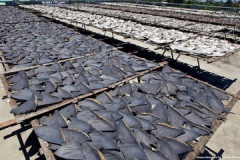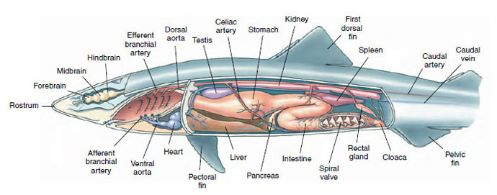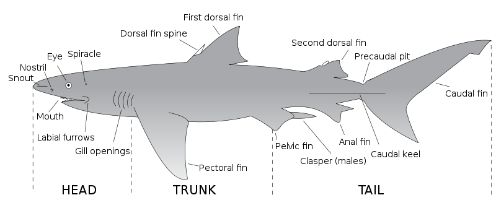Difference between revisions of "Shark fins"
m |
m |
||
| Line 14: | Line 14: | ||
[[FILE:Shark-fins.jpg]]<br><br> | [[FILE:Shark-fins.jpg]]<br><br> | ||
| − | [[FILE:Shark-fins-2.jpg]] | + | [[FILE:Shark-fins-2.jpg]]<br><br> |
| + | <b>Tails</b><br> | ||
| + | Tails provide thrust, making speed and acceleration dependent on tail shape. Caudal fin shapes vary considerably between shark species, due to their evolution in separate environments. Sharks possess a heterocercal caudal fin in which the dorsal portion is usually noticeably larger than the ventral portion. This is because the shark's vertebral column extends into that dorsal portion, providing a greater surface area for muscle attachment. This allows more efficient locomotion among these negatively buoyant cartilaginous fish. By contrast, most bony fish possess a homocercal caudal fin.<br><br> | ||
| + | Tiger sharks have a large upper lobe, which allows for slow cruising and sudden bursts of speed. The tiger shark must be able to twist and turn in the water easily when hunting to support its varied diet, whereas the porbeagle shark, which hunts schooling fish such as mackerel and herring, has a large lower lobe to help it keep pace with its fast-swimming prey. Other tail adaptations help sharks catch prey more directly, such as the thresher shark's usage of its powerful, elongated upper lobe to stun fish and squid.<br><br> | ||
| + | <b>Fins</b><br> | ||
| + | Fin skeletons are elongated and supported with soft and unsegmented rays named ceratotrichia, filaments of elastic protein resembling the horny keratin in hair and feathers. Most sharks have eight fins. Sharks can only drift away from objects directly in front of them because their fins do not allow them to move in the tail-first direction.<br><br> | ||
| + | <b>Additional information</b><br> | ||
| + | It is estimated that 100 million sharks are killed by people every year, due to commercial and recreational fishing. Shark finning yields are estimated at 1.44 million metric tons for 2000, and 1.41 million tons for 2010. Based on an analysis of average shark weights, this translates into a total annual mortality estimate of about 100 million sharks in 2000, and about 97 million sharks in 2010, with a total range of possible values between 63 and 273 million sharks per year. Sharks are a common seafood in many places, including Japan and Australia. In the Australian state of Victoria, shark is the most commonly used fish in fish and chips, in which fillets are battered and deep-fried or crumbed and grilled. In fish and chip shops, shark is called flake. In India, small sharks or baby sharks (called sora in Tamil language, Telugu language) are sold in local markets. Since the flesh is not developed, cooking the flesh breaks it into powder, which is then fried in oil and spices (called sora puttu/sora poratu). The soft bones can be easily chewed. They are considered a delicacy in coastal Tamil Nadu. Icelanders ferment Greenland sharks to produce hákarl, which is widely regarded as a national dish. During a four-year period from 1996 to 2000, an estimated 26 to 73 million sharks were killed and traded annually in commercial markets.<br><br> | ||
| + | Sharks are often killed for shark fin soup. Fishermen capture live sharks, fin them, and dump the finless animal back into the water. Shark finning involves removing the fin with a hot metal blade. The resulting immobile shark soon dies from suffocation or predators. Shark fin has become a major trade within black markets all over the world. Fins sell for about $300/lb in 2009. Poachers illegally fin millions each year. Few governments enforce laws that protect them. In 2010 Hawaii became the first U.S. state to prohibit the possession, sale, trade or distribution of shark fins. From 1996 to 2000, an estimated 38 million sharks had been killed per year for harvesting shark fins.<br><br> | ||
| + | Shark fin soup is a status symbol in Asian countries, and is considered healthy and full of nutrients. Sharks are also killed for meat. European diners consume dogfishes, smoothhounds, catsharks, makos, porbeagle and also skates and rays. However, the U.S. FDA lists sharks as one of four fish (with swordfish, king mackerel, and tilefish) whose high mercury content is hazardous to children and pregnant women.<br><br> | ||
| + | ==Shipment / Storage / Risk factors== | ||
| + | Emit a penetrating odour similar to ammonia and require separate stowage. To be stowed in a GP container as "wet" goods with an inner-liner fitted. Dry-Bag desiccants should also be inserted and ventilation from passive vents taped off where applicable.<br><br> | ||
| + | See also [[Fish, frozen]] and [[Fish, dried]] | ||
Revision as of 09:02, 6 August 2014
| Infobox on Shark fins | |
|---|---|
| Example of Shark fins |  |
| Facts | |
| Origin | - |
| Stowage factor (in m3/t) | - |
| Humidity / moisture | - |
| Ventilation | - |
| Risk factors | See text |
Shark fins
Description / Application
Sharks are a group of fish characterized by a cartilaginous skeleton, five to seven gill slits on the sides of the head, and pectoral fins that are not fused to the head. Modern sharks are classified within the clade Selachimorpha (or Selachii), and are the sister group to the rays. However, the term "shark" has also been used for extinct members of the subclass Elasmobranchii outside the Selachimorpha, such as Cladoselache and Xenacanthus. Under this broader definition, the earliest known sharks date from more than 420 million years ago.
Since, sharks have diversified into over 470 species. They range in size from the small dwarf lanternshark (Etmopterus perryi), a deep sea species of only 17 centimetres in length, to the whale shark (Rhincodon typus), the largest fish in the world, which reaches approximately 12 metres. Sharks are found in all seas and are common to depths of 2,000 metres. They generally do not live in freshwater although there are a few known exceptions, such as the bull shark and the river shark, which can survive in both seawater and freshwater. They breathe through five to seven gill slits. Sharks have a covering of dermal denticles that protects their skin from damage and parasites in addition to improving their fluid dynamics. They have several sets of replaceable teeth.
Well-known species such as the great white shark, tiger shark, blue shark, mako shark, and the hammerhead shark are apex predators—organisms at the top of their underwater food chain. Their survival is threatened by human-related activities.

Tails
Tails provide thrust, making speed and acceleration dependent on tail shape. Caudal fin shapes vary considerably between shark species, due to their evolution in separate environments. Sharks possess a heterocercal caudal fin in which the dorsal portion is usually noticeably larger than the ventral portion. This is because the shark's vertebral column extends into that dorsal portion, providing a greater surface area for muscle attachment. This allows more efficient locomotion among these negatively buoyant cartilaginous fish. By contrast, most bony fish possess a homocercal caudal fin.
Tiger sharks have a large upper lobe, which allows for slow cruising and sudden bursts of speed. The tiger shark must be able to twist and turn in the water easily when hunting to support its varied diet, whereas the porbeagle shark, which hunts schooling fish such as mackerel and herring, has a large lower lobe to help it keep pace with its fast-swimming prey. Other tail adaptations help sharks catch prey more directly, such as the thresher shark's usage of its powerful, elongated upper lobe to stun fish and squid.
Fins
Fin skeletons are elongated and supported with soft and unsegmented rays named ceratotrichia, filaments of elastic protein resembling the horny keratin in hair and feathers. Most sharks have eight fins. Sharks can only drift away from objects directly in front of them because their fins do not allow them to move in the tail-first direction.
Additional information
It is estimated that 100 million sharks are killed by people every year, due to commercial and recreational fishing. Shark finning yields are estimated at 1.44 million metric tons for 2000, and 1.41 million tons for 2010. Based on an analysis of average shark weights, this translates into a total annual mortality estimate of about 100 million sharks in 2000, and about 97 million sharks in 2010, with a total range of possible values between 63 and 273 million sharks per year. Sharks are a common seafood in many places, including Japan and Australia. In the Australian state of Victoria, shark is the most commonly used fish in fish and chips, in which fillets are battered and deep-fried or crumbed and grilled. In fish and chip shops, shark is called flake. In India, small sharks or baby sharks (called sora in Tamil language, Telugu language) are sold in local markets. Since the flesh is not developed, cooking the flesh breaks it into powder, which is then fried in oil and spices (called sora puttu/sora poratu). The soft bones can be easily chewed. They are considered a delicacy in coastal Tamil Nadu. Icelanders ferment Greenland sharks to produce hákarl, which is widely regarded as a national dish. During a four-year period from 1996 to 2000, an estimated 26 to 73 million sharks were killed and traded annually in commercial markets.
Sharks are often killed for shark fin soup. Fishermen capture live sharks, fin them, and dump the finless animal back into the water. Shark finning involves removing the fin with a hot metal blade. The resulting immobile shark soon dies from suffocation or predators. Shark fin has become a major trade within black markets all over the world. Fins sell for about $300/lb in 2009. Poachers illegally fin millions each year. Few governments enforce laws that protect them. In 2010 Hawaii became the first U.S. state to prohibit the possession, sale, trade or distribution of shark fins. From 1996 to 2000, an estimated 38 million sharks had been killed per year for harvesting shark fins.
Shark fin soup is a status symbol in Asian countries, and is considered healthy and full of nutrients. Sharks are also killed for meat. European diners consume dogfishes, smoothhounds, catsharks, makos, porbeagle and also skates and rays. However, the U.S. FDA lists sharks as one of four fish (with swordfish, king mackerel, and tilefish) whose high mercury content is hazardous to children and pregnant women.
Shipment / Storage / Risk factors
Emit a penetrating odour similar to ammonia and require separate stowage. To be stowed in a GP container as "wet" goods with an inner-liner fitted. Dry-Bag desiccants should also be inserted and ventilation from passive vents taped off where applicable.
See also Fish, frozen and Fish, dried












